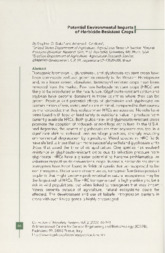Potential environmental impacts of herbicide-resistant crops.
Potential environmental impacts of herbicide-resistant crops.
Autoria: DUKE, S. O.; CERDEIRA, A. L.
Resumo: Transgenic bromoxynil-, glufosinate-, and glyphosate-resistant crops have been commercialized and grown extensively in the Western Hemisphere and, to a lesser extent, elsewhere. Bromoxynil-resistant crops have been removed from the market. Few new herbicide-resistant crops (HRCs) are likely to be introduced in the near future. Glyphosate-resistant cotton and soybean have become dominant in those countries where they can be grown. Previous and potential effects of glufosinate and glyphosate on contamination of soil, water, and air are minimal, compared to that caused by the herbicides that they replace when HRCs are adopted. No risks have been found with food or feed safety or nutritional value in products from currently available HRCs. Both glufosinate- and glyphosate-resistant crops promote the adoption of reduced- or no-tillage agriculture. In the U.S.A. and Argentina, the advent of glyphosate-resistant soybeans resulted in a significant shift to reduced- and no-tillage practices, strongly reducing environmental degradation by agriculture. Weed species in HRC fields have shifted to those that can more successfully withstand glyphosate or to those that avoid the time of its application. One weed species has evolved resistance in glyphosate-resistant crops. HRCs have greater potential to become problems as volunteer crops than do conventional crops. In canola, herbicide resistance transgenes have been found in fields of canola that are supposed to be non transgenic. Under some circumstances, tansgene flow (introgression) to plants that might become problems in natural ecosystems may be the largest risk of HRCs. The HRC transgene itself is highly unlikely to be a risk in wild populations, but when linked to transgenes that may impart fitness benefits outside of agriculture, natural ecosystems could be affected. The development and use of failsafe introgression barriers in crops with such linked genes is highly encouraged.
Ano de publicação: 2005
Tipo de publicação: Parte de livro (capítulos de livros, trabalhos e resumos publicados em anais ou em coletâneas)
Unidade: Embrapa Meio Ambiente
Palavras-chave: Agricultura, Biossegurança, Biotecnologia, Engenharia Genética, Herbicida, Impacto Ambiental, Planta, Resistência a Produtos Químicos
Observações
1 - Por padrão são exibidas publicações dos últimos 20 anos. Para encontrar publicações mais antigas, configure o filtro ano de publicação, colocando o ano a partir do qual você deseja encontrar publicações. O filtro está na coluna da esquerda na busca acima.
2 - Para ler algumas publicações da Embrapa (apenas as que estão em formato ePub), é necessário ter, no celular ou computador, um desses softwares gratuitos. Sistemas Android: Google Play Livros; IOS: iBooks; Windows e Linux: software Calibre.
Acesse outras publicações
Acesse a Base de Dados da Pesquisa Agropecuária (BDPA) para consultar o acervo completo das bibliotecas da Embrapa.

